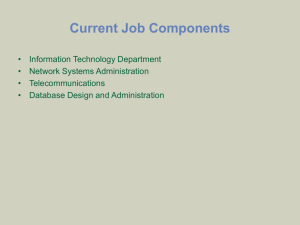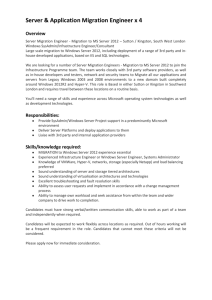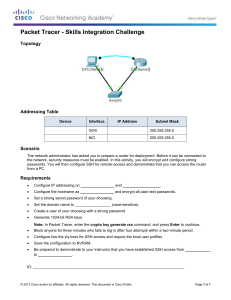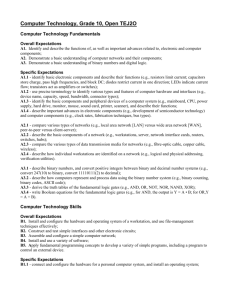Chapter 1 - An Introduction to System Administration
advertisement
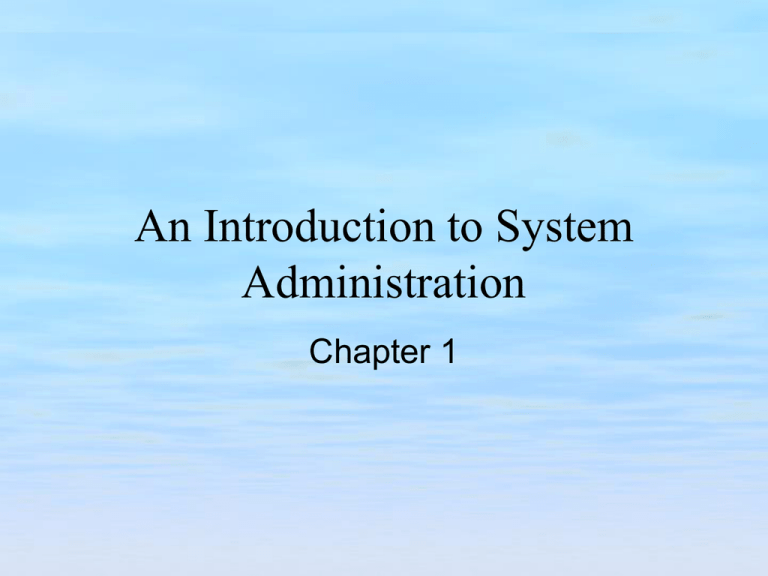
An Introduction to System Administration Chapter 1 Chapter Objectives • • • • Explore the world of the Sysadmin. List the duties of the Sysadmin. List the skill set required of the Sysadmin. List a few personality traits of a typical Sysadmin. What Is a Sysadmin? • In a “small company” the Sysadmin may be the entire information technology staff. – The Sysadmin may do everything from telephone, to fax, to computer management. – Sysadmin may have to order supplies, deal with users, develop software, repair hardware, and laugh at the CEO’s jokes! What Is a Sysadmin? • In a large company the Sysadmin may be one member of a large group. – May be responsible for one aspect of the data center operation. • Programmers • Database Administrators • Network Administrators • Operators – May not even know what the CEO looks like. Common Sysadmin Traits • A Sysadmin is a customer service agent! • The Sysadmin must be able to communicate with technical and non-technical users. • The Sysadmin should be patient, and have a sense of humor. • The Sysadmin must be able to solve difficult technical problems. • The Sysadmin must be able to work in a group setting. • The Sysadmin must document activities in order to reproduce the results. What Does a Sysadmin Do? • Plan and manage the machine room environment – design machine room; specify cooling, cabling, power connections, and environmental controls (fire alarm, security) • Install and maintain operating system software, application software, and patches. • Determine hardware and software pre-requisites, which patches to install, which services to provide, and which services to disable. What Does a Sysadmin Do? • Schedule downtime to perform upgrades/patches, and test devices and schedule downtime to manage devices. • Install and maintain user accounts; develop acceptable use policy and login-name policy; determine password change policies; install/configure/manage name services; and manage licenses. • Determine disk quota, police/manage disk space, and monitor log files. What Does a Sysadmin Do? • Train users on software and security. • Ensure that users have access to documentation. • Help users and provide help-desk support and problem tracking system to answer user questions. • Configure network services: – printing, file sharing, name service. – determine file sharing needs and printing policies. – manage security for shared resources. What Does a Sysadmin Do? • Install/maintain system devices, hardware/drivers; specify supported devices; determine spares practices. • Install/configure/manage web servers, configure web access agents • Configure and maintain business applications – – – – web agents e-mail calendar software order/problem tracking software What Does a Sysadmin Do? • Install/configure/manage e-mail software – mail transfer agents. – mail readers. • Configure and manage system security – security for business applications, – read security mailing lists and CERT notifications, – install/configure "firewall" software to limit intruder access, – collect evidence in case of successful intrusion and clean up after intrusion What Does a Sysadmin Do? • Configure and maintain connectivity between hosts – monitor connectivity – troubleshoot connectivity problems – investigate complaints of poor response What Does a Sysadmin Do? • Configure and maintain system backups, – determine backup strategy and policies, and – configure backup software – perform backups – monitor backup logs – check backup integrity – determine disaster survival plans – perform restores What Does a Sysadmin Do? • Troubleshoot and repair system problems; and determine, locate, and repair/replace problem components • Document the system, and develop and maintain documentation on local setup and local policies Skills Required • • • • • • Delegation and Time Management Ethics Ability to create/follow Policies and Procedures Desire to learn Customer Service Attitude Knowledge of technical aspects – Hardware – Software – Problem Solving Chapter Summary • Sysadmins are often viewed as “a jack of all trades” • Sysadmins are customer service oriented. • Sysadmins need to be able to communicate clearly. • Sysadmins need to be able to solve problems • Sysadmins need to be analytical thinkers.
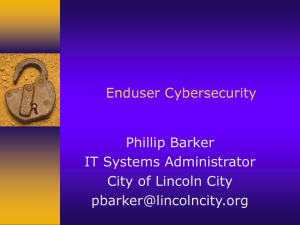
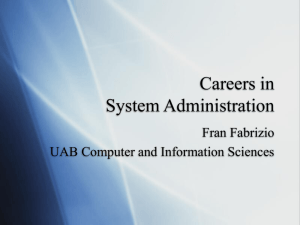
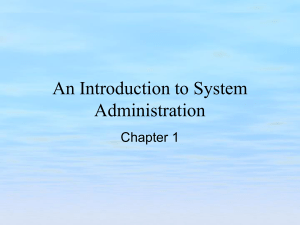
![[#GRP-871] MembershipFinder.findMemberships doesn`t appear to](http://s3.studylib.net/store/data/007422299_1-e8f5b300a55fd76701b09e629a1c1653-300x300.png)
